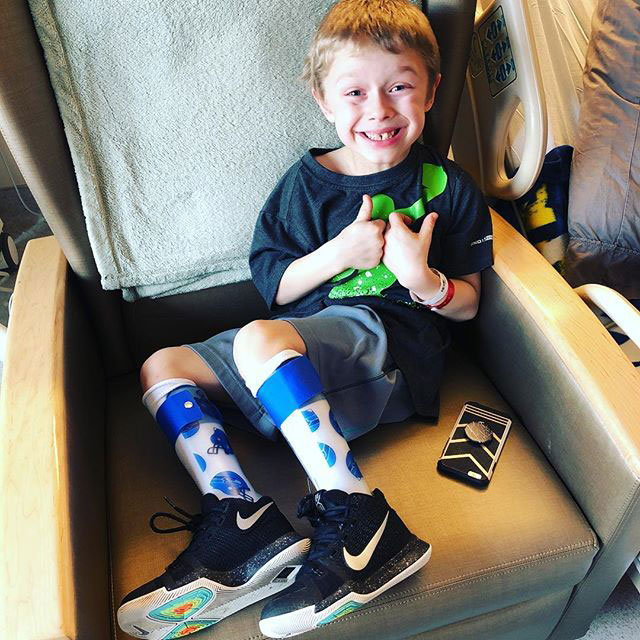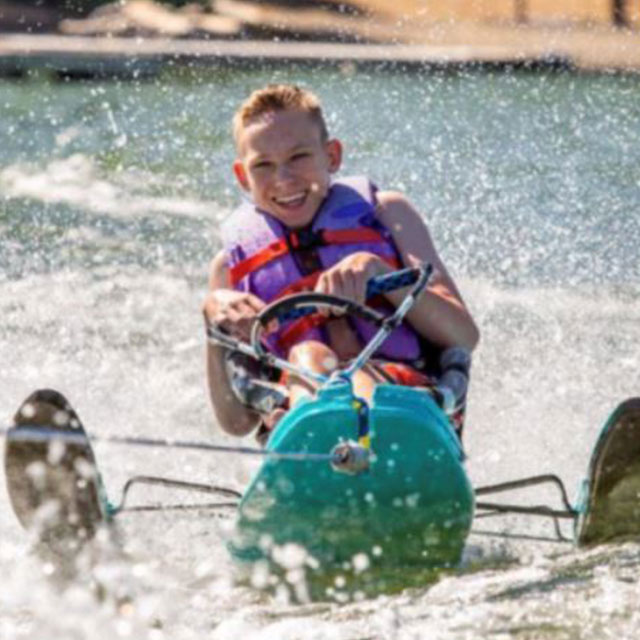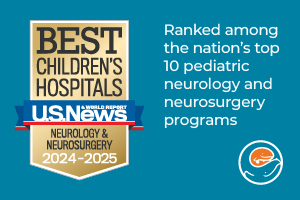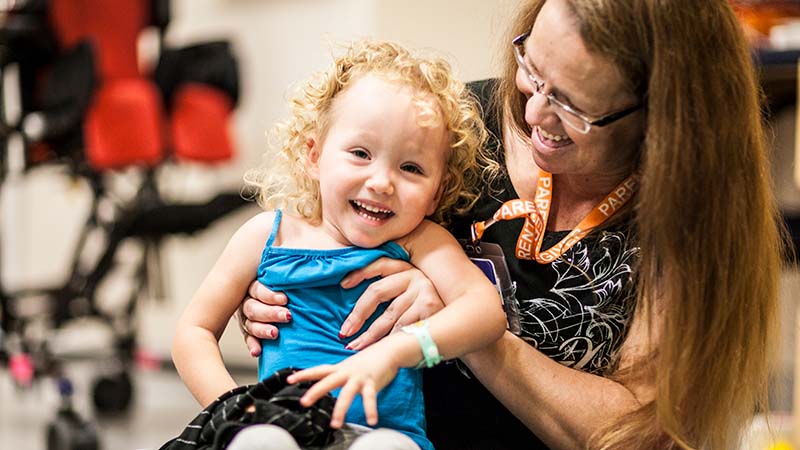Cerebral Palsy (CP)
What is cerebral palsy?
Cerebral palsy (CP) is a general term for when a person has permanent differences in how they move and control their muscles. The differences are caused by an injury to a child’s brain. The brain injury can happen before, during or after birth. The injury itself does not change, but how it affects a child can change and worsen as they grow.
CP affects a child’s strength, muscle tone and motor control. Some children with CP have other problems that affect their motor skills, thinking, learning, speech and language.
Cerebral Palsy Care at Seattle Children's
Seattle Children’s is a national leader in pediatric rehabilitation. We provide comprehensive rehab services for children with a wide range of conditions at our hospital campus in Seattle and our clinics around the Northwest.
What are the causes, risk factors and early signs of cerebral palsy?
Sometimes it is obvious from birth that a child has CP. But sometimes you or your child’s doctor may only become concerned about CP when your child is slow to reach developmental milestones.
-
Causes of CP
CP happens when the developing brain has an injury. The injury does not get worse over time but cannot be cured. This can happen because of:
- Bleeding in the brain before, during or after birth
- Traumatic brain injury
- Lack of oxygen to the brain
- Lack of blood supply to the brain (stroke)
- Seizures
- Infections of the brain or spinal fluid
- Certain genetic conditions
-
Risk factors for CP
A risk factor is something that increases the chance a child will have CP. Risk factors for CP include:
- Early (preterm) birth and low birth weight (less than 5.5 pounds)
- Pregnancy and birth complications (such as lack of oxygen to the brain)
- Stroke before, during or after birth
- Mothers with serious health concerns including blood disorders, seizure disorders and infections (viral or bacterial)
- Exposure to harmful substances during pregnancy
-
Early signs of CP
Missing or delayed development of milestones can be a sign of CP. You may notice your baby is slower than other babies and children to:
- Roll over
- Sit up
- Crawl
- Walk
- Grab onto toys
- Talk
Babies with CP may also have trouble feeding, swallowing, hearing or seeing.
-
How CP affects a child’s body
CP has different effects on different children. Knowing how your child’s CP is classified and any related problems they have helps us decide the best treatment for your child.
There are 3 main ways to classify CP. These handouts explain how to describe your child's condition:
- Cerebral Palsy (CP) Topography: How CP Affects Parts of the Body (PDF) (Spanish)
- Cerebral Palsy (CP) Movement Disorders describes atypical body movements and postures (PDF) (Spanish)
- The Gross Motor Function Classification System (GMFCS) is used to describe levels of functional mobility and gives children with CP a score or level to describe how they will get around as they grow up. A higher level means it is harder to move without help. All handouts are PDFs.
How is cerebral palsy diagnosed?
-
Imaging studies
The doctor may schedule imaging studies to help rule out other disorders and look for brain changes that are typical of CP. These tests include:
- CT (computed tomography) scan to look for bleeding, fracture or signs of high pressure in the brain.
- MRI (magnetic resonance imaging) to look for areas of damage in the brain.
- Cranial ultrasound to show the brain’s structure. It is often used with babies born early because it is easier on the baby than other tests.
-
Evaluation by specialists
At Seattle Children’s, we have specialists who can help confirm a diagnosis of CP and plan treatment to address all your child’s needs. These include doctors who specialize in:
- The central nervous system (neurologist)
- How the nervous system develops (neurodevelopmental pediatrician)
- Eyes (ophthalmologist)
- Hearing (audiologist)
- Helping children improve their body's function (rehabilitation medicine physician)

“As we’ve discovered new options, we’re all about pushing the limits so that Reid can have the life he wants. We let that drive us instead of focusing on what he can and can’t do.”
- Kaitlin Watkins, Reid’s mom.
Nonsurgical Treatments for Cerebral Palsy
We offer many types of treatments to help children with CP stay healthy and be more comfortable in their bodies. Our Neurodevelopmental team works with your child, your family, your child’s primary care provider and other specialists to address your child’s:
- Behavior
- Thinking and learning (cognition)
- Development
- Drooling (saliva management)
- Nutrition
- Sleep
The doctors, nurse practitioners and therapists in Rehabilitation Medicine provide a range of treatments. Your child may benefit from options such as:
- Bowel and bladder management
- Pain management
- Tone management
- Wound care
- Physical therapy, including help with walking (gait training), equipment and stretching muscles using a cast (serial casting)
- Speech therapy, including therapy to ease difficulty with swallowing (dysphagia) (PDF) (Spanish) (Vietnamese)
- Occupational therapy, including constraint induced therapy (CIT) (PDF) (Spanish)
- Orthotics (braces that can help with balance, walking and movement)
- Medicines taken by mouth to help relax your child’s muscles
- Botox Injections for Tight Muscles (PDF) (Russian) (Spanish)
- Phenol Injections for Tight Muscles (PDF) (Spanish)
Neurosurgery for CP
Neurosurgery may be an option if your child needs more relief from spasticity or dystonia than they can get with nonsurgical treatments.
Our Tone Management Program assesses and treats children with spasticity who might benefit from neurosurgery. Our Rehabilitation Medicine and Neurosurgery teams work together to understand your child’s needs and to plan and provide their care. This includes planning the therapy they will need after surgery.
Neurosurgeons at Seattle Children’s do these surgeries to lessen spasticity in children with CP:
Selective dorsal rhizotomy (SDR)
Selective dorsal rhizotomy (SDR) is a surgery done on the lower spinal cord to reduce high muscle tone (spasticity) in the legs.
The goal of SDR is to relax the muscles by finding and cutting the nerves that are causing spasticity. This can improve your child’s ability to move and their quality of movement.
Our team of providers, surgeons and therapists (physical and occupational) will carefully screen your child, talk with you and get input from your child’s community therapist to decide if this surgery might help your child.
Rehabilitation after SDR is important so your child gets the full benefit from surgery. When independent walking is the goal, we offer the option of custom inpatient therapy in our Rehabilitation unit after surgery for 2 to 3 weeks. Your family may choose to have therapy closer to home if inpatient rehabilitation does not fit your needs. Your local therapist will be a valued partner in your child’s therapy plan at home.
Learn more about SDR.
For nonmobile children with severe spasticity, we offer innovative surgical options to reduce pain and make it easier to provide their daily care.
“Quality of life is dramatically improved with SDR. Kids are able to move easier, their stamina is improved and they are better able to manage their body movements.”
- Dr. Sam Browd, surgical director and neurosurgeon for Seattle Children’s Tone Management Program
Baclofen pump surgery
In this surgery, the neurosurgeon places a pump under the skin in your child’s belly (abdomen). The pump is about 4 inches wide and less than 1 inch thick. It delivers a constant small amount of a medicine called baclofen into the fluid around your child’s spine.
Baclofen relaxes muscles and reduces spasticity and dystonia throughout your child’s body. The medicine goes straight into your child’s spinal fluid. It works better than taking baclofen by mouth or by feeding tube, allowing for a much lower dose. This reduces side effects, such as feeling too relaxed or sleepy.
After the neurosurgeon implants the pump, the infusion of baclofen will be slowly increased to the right dose for your child. The baclofen pump must be filled with medicine every 1 to 6 months, depending on your child’s dose. This can be done at Seattle Children’s or by a community infusion clinic or home infusion agency. After 6 to 7 years, your child will need surgery to replace the battery-powered baclofen pump.
Learn more about the Intrathecal Baclofen (ITB) Pump Implant: A treatment for severe spasticity (PDF) and the Intrathecal Baclofen (ITB) Test Dose (PDF) (Spanish).
Orthopedic Surgery for CP
Some children with CP may need surgery to:
- Lengthen muscles and tendons that keep their joints from moving through the normal range of motion (contractures)
- Prevent contractures from getting worse
- Change the shape and alignment of bones deformed by contractures
- Align bones to improve function, comfort or position, such as how a child sits in a wheelchair
- Fit better within their braces to prevent skin breakdown and relieve pain
- Help parents to provide care, such as bathing and dressing
Our Ortho Rehab Clinic brings together orthopedic surgeons, orthotists, physical therapists and rehabilitation medicine providers. We assess your child and decide whether orthopedic surgery may be helpful.

“I’m doing a lot better than I ever thought I would.”
- Zack Edge, who has better muscle balance and joint function as a result of orthopedic surgeries at Seattle Children’s.
Seattle Children’s provides a full range of orthopedic surgeries for children with CP, such as:
-
Hand and arm surgery
Surgery may benefit your child if CP makes it hard to do daily activities like getting dressed or writing. Orthopedic and plastic surgeons and occupational therapists work as a team in our Hand and Upper Extremity Program to help children with CP use their hands and arms better. To make daily activities easier, the surgeon may release muscles, tendons and ligaments in your child’s hand and arm to change their hand position.
-
Hip surgery
High tone in some muscles and lower tone in other muscles may lead to hip problems that cause pain or make it hard to move or sit. The ball of the hip joint may shift in the hip socket or come out of the socket. Our orthopedic surgeons offer surgeries to reshape and realign where the thigh bone meets the hip bone.
These procedures can:
- Make your child more comfortable
- Help with moving or sitting
- Keep hip problems from getting worse
- Lead to less pain and deformity over time
-
Single-event multilevel surgery (SEMLS)
If your child has several contractures or deformed bones in multiple places, they may benefit from surgery to address many or all of these concerns at once. This approach is called single-event multilevel surgery (SEMLS). Having multiple surgeries at one time means children have 1 major recovery and rehabilitation period, instead of repeated recovery and rehab.
You can read our handout Preparing for Single-Event Multilevel Surgery (SEMLS) (PDF) (Arabic) (Chinese) (Russian) (Spanish).
Our teams in Orthopedics and Sports Medicine, Physical Therapy and Rehabilitation Medicine work together to develop a detailed surgical plan for your child, mapping out each part of the surgery. We also plan the physical therapy, occupational therapy and other care your child will need after surgery to get the best results. Some children stay in our inpatient rehabilitation unit for intensive therapy after SEMLS.
-
Spine surgery
Children with CP often develop a curve in their spine called scoliosis. If the scoliosis is severe, our orthopedic surgeons may offer surgery to stop the curve from getting worse or even improve or lessen the curvature. Surgeons then stabilize the spine with a fusion.
We may recommend spinal surgery to make sitting easier if your child has a curve that makes it hard for them to sit in their wheelchair. Read more about scoliosis treatment.
Why choose Seattle Children’s for cerebral palsy care?
 Each child with CP is unique. Our aim is to give your child the best possible function and quality of life now and as they grow. Experts from across Seattle Children’s work together to give your child complete, coordinated care. We create a custom care plan, based on proven research and guidelines. We recommend the right mix of treatments and carefully time them for the best benefit to your child.
Each child with CP is unique. Our aim is to give your child the best possible function and quality of life now and as they grow. Experts from across Seattle Children’s work together to give your child complete, coordinated care. We create a custom care plan, based on proven research and guidelines. We recommend the right mix of treatments and carefully time them for the best benefit to your child.
We provide a full range of treatment options to meet the needs of children, teens and young adults with CP. These include medicines; braces (orthotics); surgeries; and occupational, physical and speech therapies. We are the only provider in the Pacific Northwest to offer selective dorsal rhizotomy (SDR) surgery to improve mobility and quality of life for children with CP.
CP cannot be cured, but treatment can help your child move more easily and feel more comfortable. Here are some resources to help your child and family manage CP.
-
The experts you need are here
Seattle Children’s has experts in all the fields your child might need. These include:
Research and Clinical Trials
Our team does research to improve the diagnosis, treatment and care of people with CP. Children we treat have the option to take part in clinical trials of promising new treatments. Our research efforts include:
- Bjornson Lab: Research focused on spastic or hypertonic CP, which affects more than 7 out of 10 children with CP
- Center for Child Health, Behavior and Development: Research to improve walking, mobility and upper extremity function
- University of Washington Steele Lab: Research to better understand how people move to improve their quality of life and ability to perform daily activities.
Contact Us
If your child has been diagnosed with CP and you would like to receive care at Seattle Children’s, ask your child’s medical provider to send a referral to our Rehabilitation Medicine program. If you have a referral, call 206-987-2114 to schedule an appointment with Rehab Medicine.
To have your child evaluated to determine if they have CP, ask their provider to send a referral to our Neurosciences Program. If you have a referral, call 206-987-2016 to make an appointment with Neurosciences
Providers, see our referral guidelines for Rehabilitation Medicine and for Neurology.
Paying for Care
Learn about paying for care at Seattle Children’s, including insurance coverage, billing and financial assistance.

